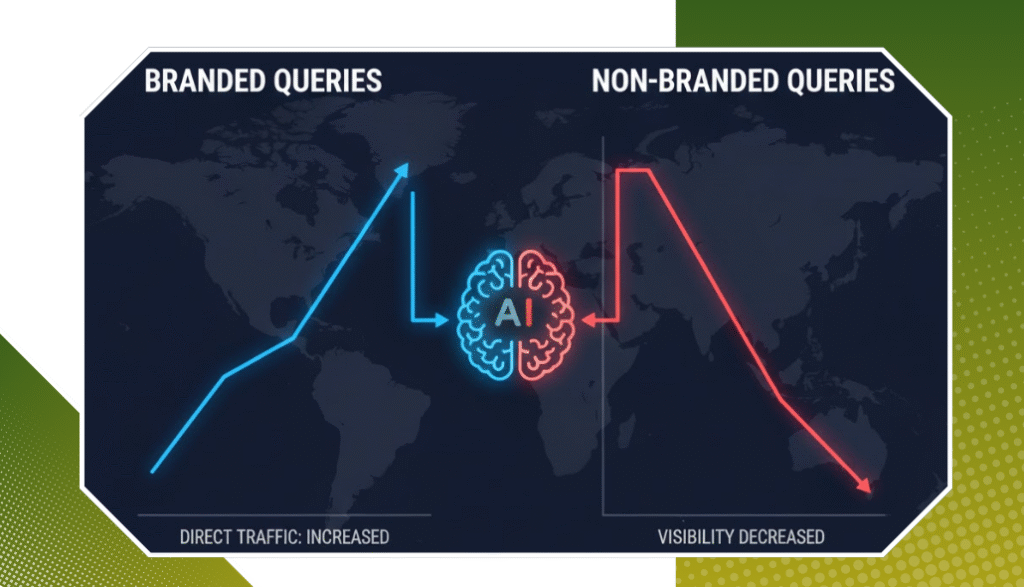AI Overviews are an advanced system that generates concise, AI-powered summaries at the top of search results. They cull through many sources, which means that users are given in-depth answers right there without the need to go to separate sites.
This shift is an important moment in the history of search engines. As AI-driven features become more common, the traditional ten blue links format seems to be losing its power. Integration of AI into search results ushers in a new age in which instant, synthesised info takes precedent over the old link-based model.
The Evolution of Search Engine Results
Search engine results pages have undergone a dramatic transformation from their early days. For many years, the model we referred to as the “ten blue links”– a simple list of relevant web pages — was the primary structure of search engines. That which used to be a standard layout gave users easy access to the source sites, which in turn made for a very productive relationship between search engines and content publishers.
The Rise of AI-Driven Summaries
The change-out at the end of the shift was seen with the adoption of AI-driven summaries. What we are seeing is that these smart overviews took over the top of the search results’ space, they put together info from many sources and presented it in a very clean, easy-to-digest way. Also, we have seen that there is a large 34.5% drop in clicks on what used to be the number one spot for organic results, which is a very clear sign of changing user trends.
Google’s AI Mode: The Next Evolution
Google’s AI Mode represents the next evolutionary leap in search technology. This advanced feature, which is Gemini 2.0 powered, transforms the search experience into an AI-centred interaction. Available to Google One Premium users in 100 countries, AI Mode includes:
- Multimodal inputs: Users may use a mix of text, voice, and image queries.
- Direct answers: In the search interface, which presents complete results.
- Dynamic comparisons: Parallel analysis of different options or topics.
- Interactive refinement: Users have the ability to improve and extend their queries through natural conversation.
A Shift in Search Mechanics
This is a great shift that sees us break away from the typical approach of traditional search functions. We now put forth to the user a synthesis of info right in the search itself, which in turn reduces the number of sites they have to visit. This change in info delivery plays with the usual role of search engines in relation to content publishers’ roles, which, in turn, we see to be the start of new search engagement patterns.
Enhancing User Experience with AI-Generated Summaries
AI-generated summaries are changing the way we search online. We no longer have to go to several sites to get what we need; instead, we are provided with in-depth and immediate answers. Also, they collect information from many sources and present it to us in a very easy-to-understand format.
How AI is Improving Search
One of the key technologies behind this improvement is natural language processing (NLP). With NLP, search engines can better understand and interpret human language. Which, in turn, we see that users are able to ask questions in a very conversational way, as they would to a person.
The Evolution of Search Interactions
Thanks to artificial intelligence (AI), search interactions have evolved from straightforward keyword inputs to dynamic conversations between users and search engines.
Here are some ways in which this evolution is taking place:
- Immediate answers: AI-powered systems can now provide instant responses to complex queries that may require multiple steps or comparisons.
- Contextual understanding: These systems are able to recall past queries, which in turn allows for better and more relevant conversations as time goes on.
- Clarification options: When it comes to ambiguous searches, our AI algorithms are able to give out interactive prompts that better understand user intent.
- Personalisation: Through analysis of search history and user preferences, AI algorithms put forth results that are tailored to individual users’ needs and interests.
Benefits of AI-Enhanced Search Experience
AI’s role in search has many benefits:
- Efficiency: Users no longer need to spend time sifting through multiple websites or articles to find what they’re looking for. With AI-generated summaries, we present at once the answers that require no extra effort.
- Accuracy: By cross-referencing information from different sources, these summaries ensure that users receive reliable and verified content.
- Convenience: The ability to ask questions naturally and receive responses in real-time makes searching more convenient and user-friendly.
The Shift from SEO to Answer Engine Optimisation (AEO)
Digital marketing is in the midst of a transformation as AI is redefining what the space is about. What used to be the mainstay of SEO, that is, keyword optimisation, building backlinks and improving technical aspects of a web page, is now giving way to what we see in Answer Engine Optimisation (AEO).
A New Approach to Content Creation
AEO has a different approach in terms of what they put out there. Instead of just going for the top spot in search engines, content producers must present info in a way that perfectly answers user questions and that AI will find easy to use and reference.
Here are some key strategies for implementing AEO:
- Create clear question-and-answer formats
- Include detailed FAQ sections
- Provide factual, data-driven content
- Break up complex issues into simple elements
The Importance of Structured Data
One of the elements to that we see value in for AEO is the use of structured data formats. Through the implementation of schema markup and other forms of structured data, content creators may also see that machines and AI better understand and interact with their web pages.
The Role of Content Quality and Authority
When it comes to our AEO strategies, what is put out there in terms of content is of the utmost importance. We as websites must position ourselves as authorities, which we do by presenting in-depth and precise info that AI systems can count on in their summing up.
Conclusion
Search engine transformation via AI-based features is at a turning point in digital info retrieval. As we see search engines grow past the old ten blue links model, businesses must change their strategies to be present and relevant in this new environment. The success of future digital marketing efforts will depend on embracing both SEO and AEO practices while creating content that serves both human readers and AI systems.
Ready to adapt to the change in search and still have your content remain discoverable? SEO will help you to develop what works in this tech-driven environment. Contact us at Rankingeek Marketing Agency to future-proof your digital presence.





